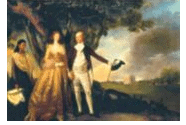Important Questions Test: The Changing World of Visual Arts - UPSC MCQ
20 Questions MCQ Test History(Prelims) by UPSC Toppers - Important Questions Test: The Changing World of Visual Arts
What techniques did the painters of Murshidabad and Patna adapt from the British while making post cards?
Abanindranath Tagore and a new group of nationalist artists rejected the art of Ravi Verma because
| 1 Crore+ students have signed up on EduRev. Have you? Download the App |
This great piece of work is by a painter from Europe who came to India in the mid- 1780s. Who painted this?

From the two oil paintings given below by Johann Zoffany, what is the main inference that one can make about the lifestyle and attitude during Colonial India.
Name the Nawab who fought against the British Resident controlling the affairs of the state in the 1770s and later became a dependent pensioner of the East India Company
Name the two European artists commissioned by Muhammed Ali Khan.
Name the artist who painted this beautiful portrait of Muhammed Ali Khan of Arcot in 1775.
Name the third category of imperial art that existed during the colonial India
Name the artist who created this painting of Lord Clive meeting Mir Jafar after the Battle of Plassey. Considered to be first of the series of history paintings, this was placed on public display in the Vauzhall Gardens in London.
The painting The Storming of Seringapatnam portrayed the celebration of the British military triumph over Tipu Sultan. Name the painter of this important painting full of action and energy.
This oil painting by David Wilkie in 1839 glorifies the British triumph over something. Name the occasion where General Sir David Baird seems to announce this is the fate of those who dare to oppose the British.
Tipu Sultan encouraged a special type of wall painting. What is this called as?
The following mural painting depicts the celebration by Tipu Sultan and Haidar Ali after defeating the English troops. Name the battle that was fought in 1780.
The following image is a miniature copy by a local court painter of an oil painting by the visiting British artist G Farrington depicting a procession on the occasion of an important festival celebrated by the Muslims. Name the festival.
From the following options available which one can be called a collection of Indo-European style of paintings made in India by Indian artists
Name the pilgrimage centre of the temple village around which the scroll painters and potters began developing a new style of art in Bengal.
What is the specialty of the early Kalighat paintings ?
Identify this style of painting. This painting is a typical example of how Patuas depicted English life in India where hunting was considered as a sport that demonstrated courage and manliness
Name the important printing press set up at Calcutta in the late 19th century started by the middle class Indians, producing life like images of eminent Bengali personalities as well as mythological pictures.
Following image is an advertisement of a popular Indian brand of a product /item that was banned by the British in 1905. This image was used to express nationalist ideas and inspire people against the British rule by the Calcutta art Studio. Guess the product/item.
|
32 videos|98 docs|135 tests
|
|
32 videos|98 docs|135 tests
|

















